The Camino Primitivo is one of the lesser-known routes of the Camino de Santiago — and also one of the most fascinating. It winds through a mountainous, quiet, and less-traveled region, offering a very different experience from the busier paths like the Camino Francés.
If you’re looking for a more peaceful and intimate alternative — and you’re not afraid of walking through remote rural areas — then the Camino Primitivo route might be exactly what you need.
In this article, I share my full experience on the Camino Primitivo, along with practical info to help you prepare: a suggested stage breakdown, what gear to bring, accommodation options, level of difficulty, and the most beautiful parts of the trail. The goal is to give you a clear idea of what to expect — whether you plan to walk just a few days or take on the entire route from start to finish.
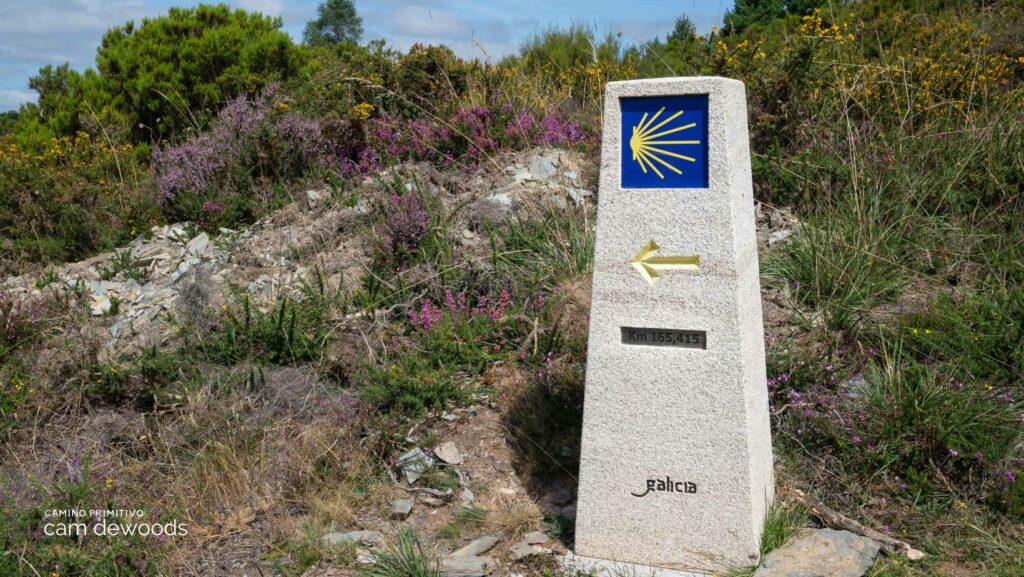
Sommaire
My experience on the Camino Primitivo
I discovered the Camino Primitivo kind of by accident, back in 2018. I had originally set out on the Camino del Norte, but after several weeks of coastal walking, I felt like switching gears. Just before Oviedo, in the town of Villaviciosa, I made a spontaneous decision — almost overnight — to take a different route. I’d heard that the Camino Primitivo route was more “inland,” more nature-oriented, quieter. And I was really drawn to that.
So I headed toward Oviedo and started walking a brand-new Camino, without knowing exactly what to expect. The scenery changed quickly: you walk further inland, the stages are more physically demanding, but nothing overwhelming. What I loved right away was the feeling of space, time, and silence. Sure, you still meet people — it’s still part of the Camino de Santiago in Spain — but this one felt more discreet, more stripped-back. And that was exactly what I needed.
I finished in Santiago feeling like I’d lived something completely different from my previous Caminos. I ended up writing a book about it later — mostly to process it, but also to hold on to that special moment in time.
If you’re also hesitating between several routes, I’ll share everything you need to know in the next sections — so you can decide if the Camino Primitivo is the right path for you.

What is the Camino Primitivo?
Origins and history of the Camino Primitivo
The Camino Primitivo — which translates to “Primitive Way” — is considered the oldest Camino de Santiago route. According to tradition, it dates back to the 9th century, when King Alfonso II of Asturias became the first pilgrim to walk to Santiago de Compostela after hearing of the discovery of the tomb believed to belong to the apostle James. His journey is said to have created the very first Camino Primitivo route.
Historically, the Camino Primitivo connected the city of Oviedo to Santiago de Compostela, crossing the rugged mountains of Asturias before reaching the inland regions of Galicia. For centuries, this path was less traveled than easier alternatives like the Camino Francés, but in recent years, it’s seen a resurgence among pilgrims seeking a quieter, more off-the-beaten-path experience.
Where does the Camino Primitivo start and end?
The Camino Primitivo officially starts in Oviedo, the capital of Asturias, and ends in Santiago de Compostela. The trail first climbs through the mountains of Asturias, then crosses into Galicia, joining the Camino Francés in the town of Melide, where it shares the final 3 to 4 stages to Santiago.
The Camino Primitivo distance is around 310 to 320 kilometers, depending on the variants and detours you take.
So, how long does it take to walk the Camino Primitivo? Most people complete it in 12 to 15 days, depending on pace, weather, how the Camino Primitivo stages are divided, and whether you take any rest days.It’s a shorter route than the Francés or the Norte, but don’t underestimate it — the elevation gain is significant, and some sections are quite demanding. That said, there’s no pressure to rush. You can take your time, split stages as needed, and enjoy the full journey — whether you walk it all at once or in sections.

Why choose the Camino Primitivo over another route?
Comparing the Camino Primitivo to the Camino Francés and the Camino del Norte
When you start researching the different Camino de Santiago routes, you’ll quickly come across the most popular ones: the Camino Francés, and increasingly, the Camino del Norte. The Camino Primitivo, meanwhile, stays a bit more under the radar — and yet, it offers something truly unique.
The Camino Francés is the most famous and the busiest. It’s well-organized, accessible, and full of that “Camino energy” — you meet a lot of people, there’s infrastructure everywhere, and you can make decisions day by day. The Camino del Norte, which I followed for over 20 days before switching to the Primitivo, follows the northern coast and offers beautiful ocean views all the way to Santiago.
The Camino Primitivo, by comparison, is shorter than these two and allows you to reach Santiago in fewer days — but it does require stronger legs. You quickly leave behind the bigger towns and dive into more rural, hilly landscapes. Some stages are long, and the terrain is more rugged. But that’s also its charm: a wilder, more stripped-back trail.
That said, it’s not the “hardcore” version of the Camino — far from it. It’s just a bit more demanding. If you want to know more about why people choose the Camino in the first place, check out my article Why do people walk the Camino de Santiago?
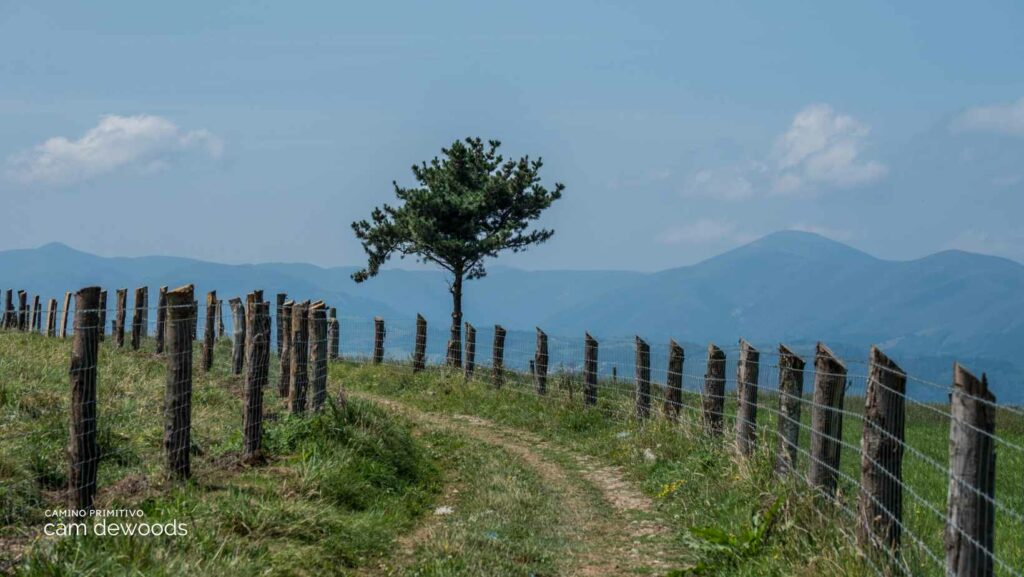
Who is the Camino Primitivo for (and who might want to wait)?
Honestly, I wouldn’t necessarily recommend the Camino Primitivo as a very first Camino — especially if you’re not used to long-distance walking. It’s not that it’s “only for the tough ones” — I met all kinds of pilgrims on the trail, of every age and fitness level. But here’s the thing: there are fewer accommodation options than on other routes. That means it’s harder to adjust your walking days on the fly if you get tired.
On other routes, you can often walk 10 km, stop, and pick up again the next day. On the Primitivo, that’s not always possible: sometimes it’s 25 km or nothing. And in the more rural stages, you’ll need to check ahead that there’s space in the albergue — or be okay sleeping in a basic shelter if that’s the only option.
So, if it’s your very first long walk and you’re unsure about your fitness level or pacing, you might want to start with a stretch of the Camino Francés or the Via Podiensis, which are more flexible. But if you’ve got a bit of time, a decent base level of fitness, and you’re craving a quieter, more immersive experience — go for it.
The Camino Primitivo is a stunning route, full of depth, solitude, and authenticity.
When to walk the Camino Primitivo?
Weather conditions on the Camino Primitivo
The Camino Primitivo crosses two main regions in northern Spain: Asturias, known for its mountains, and Galicia, famous for its green landscapes… and frequent rain. So let’s be clear from the start: weather is a real factor to consider on this route. It’s not the driest Camino, and you should expect a few rainy days — no matter the season.
In May, June, and September, conditions are generally great for walking: moderate temperatures, long daylight hours, and fewer crowds compared to other routes. I walked part of the Camino Primitivo in June, and even then, I had a couple of seriously wet days. Nothing dramatic, but make sure to pack a proper waterproof jacket — not just a thin poncho.
In July and August, rain is usually less frequent, but it can get quite hot on exposed sections, especially in Galicia. And although the Camino Primitivo route remains relatively quiet, it’s more popular during summer, so it’s a good idea to book key accommodations in advance.
Best season to walk the Camino Primitivo (based on your preferences)
- Spring (April to June)
- In my opinion, this is the best time to go. Nature is in full bloom, the temperatures are perfect for hiking, and you won’t run into too many people. Just be aware that at the very start of spring (especially April), there can still be some snow in higher areas — so check conditions before setting off.
- Summer (July–August)
- More people, warmer weather, but everything is open. If you don’t mind sharing albergues with a bit more company, it’s a good option. Watch out for late-afternoon thunderstorms in the mountains, which are common during summer.
- Autumn (September–October)
- A very pleasant time to walk. There are fewer pilgrims than in summer, most albergues are still open, and the autumn light is stunning. However, October tends to bring more frequent rain, and the days start getting shorter quite quickly.
- Winter (November to March)
- Unless you’re an experienced hiker and know how to manage challenging weather, I wouldn’t recommend walking the Camino Primitivo in winter. Many accommodations are closed, and certain stages on the Camino Primitivo route can be tricky or even dangerous if conditions worsen (snow, fog, etc.).
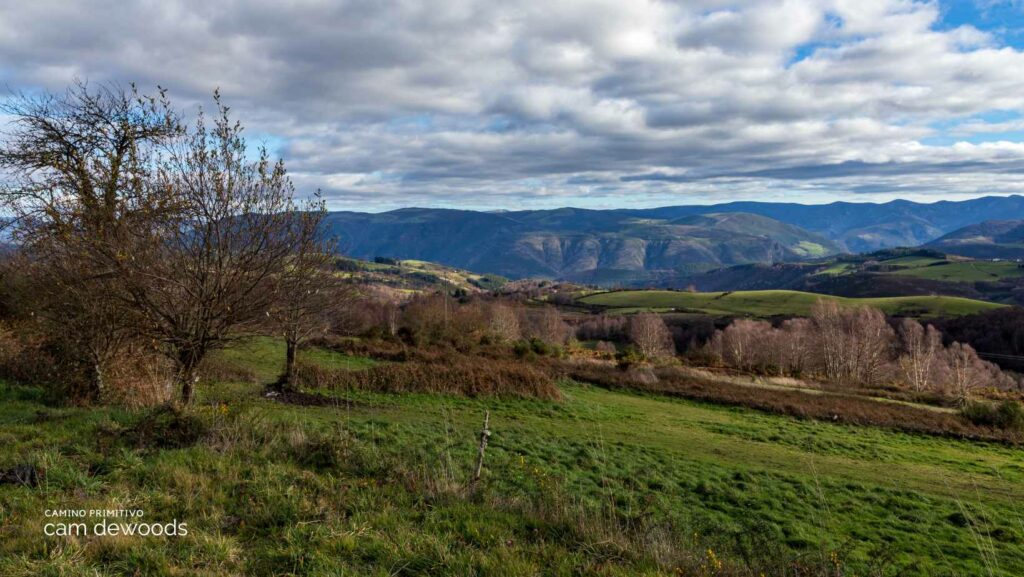
Camino Primitivo stages: what you need to know
How many stages should you plan for the Camino Primitivo?
The Camino Primitivo distance is roughly 310 to 320 km between Oviedo and Santiago de Compostela. Most pilgrims complete it in 12 to 14 stages, but that’s just a general reference. Some people walk it faster — in about 10 days — while others take more time, adding rest days or choosing shorter stages.
Personally, I joined the Camino Primitivo route after walking several weeks on the Camino del Norte, so I already had a good rhythm in my legs. Still, I quickly felt that this section was more demanding than the previous ones. There are more climbs, fewer big towns, and some long days with limited options to shorten your walk.
So it’s smart to give yourself some flexibility — either an extra day or two in your itinerary, or at least a midway rest day to reset and recharge.
Average stage distance and daily walking time
The Camino Primitivo stages typically range between 20 and 30 km, with a few longer days when there are no intermediate accommodation options. On average, you’ll walk for 5 to 7 hours per day, including breaks. Of course, it’s up to you to adapt your pace depending on your fitness level, how you’re feeling, or whether you want to stop and explore certain villages. I talk more about this flexible approach in my article How many kilometers per day on the Camino de Santiago?
Elevation is definitely something to keep in mind. While this isn’t high-altitude hiking, the early stages in Asturias are quite hilly, with several steep ascents and descents. That extra effort adds up, especially if you’re carrying a heavy pack or new to long-distance walking.
Example stage breakdown: Camino Primitivo from Oviedo to Santiago
This Camino Primitivo route suggestion can of course be adapted depending on your fitness, preferences, and weather conditions. Here’s a common 14-day itinerary:
O Pedrouzo → Santiago de Compostela (20 km)
The final stage, ending at the cathedral in Santiago de Compostela.
Oviedo → Grado (25 km)
Starting at Oviedo Cathedral, this first stage leads you through rolling hills to the town of Grado.
Grado → Salas (22 km)
A scenic stage through charming villages and forested paths, ending in Salas, known for its historic architecture.
Salas → Tineo (20 km)
A steady uphill walk with wide views and a finish in the historical town of Tineo.
Tineo → Pola de Allande (28 km)
A longer day with a mix of wooded paths and meadows, ending in Pola de Allande.
Pola de Allande → Berducedo (17 km)
Steep climb to Alto del Palo (1,146 m), followed by a descent to Berducedo.
Berducedo → Grandas de Salime (20 km)
Descend toward the Salime reservoir, then climb up to Grandas de Salime with beautiful mountain views.
Grandas de Salime → A Fonsagrada (25 km)
Entering Galicia via the Alto do Acevo pass, then downhill to A Fonsagrada.
A Fonsagrada → O Cádavo (24 km)
A mix of ups and downs through classic Galician countryside and stone villages.
O Cádavo → Lugo (30 km)
A longer but easier stage leading to Lugo and its famous Roman walls.
Lugo → San Romao da Retorta (19 km)
Quiet walking through rural landscapes as you leave the city behind.
San Romao da Retorta → Melide (27 km)
Continued walk through countryside until reaching Melide, where the route joins the Camino Francés.
Melide → Arzúa (14 km)
A short stage on the Camino Francés, known for local food specialities.
Arzúa → O Pedrouzo (19 km)
Gentle walking through eucalyptus forests, getting closer to Santiago.
This Camino Primitivo stage breakdown is only a suggestion — you can always adapt it based on your personal pace, available accommodations, and how your body feels day to day. Careful planning helps, especially on this less-traveled route, to make sure you enjoy the journey safely and fully.
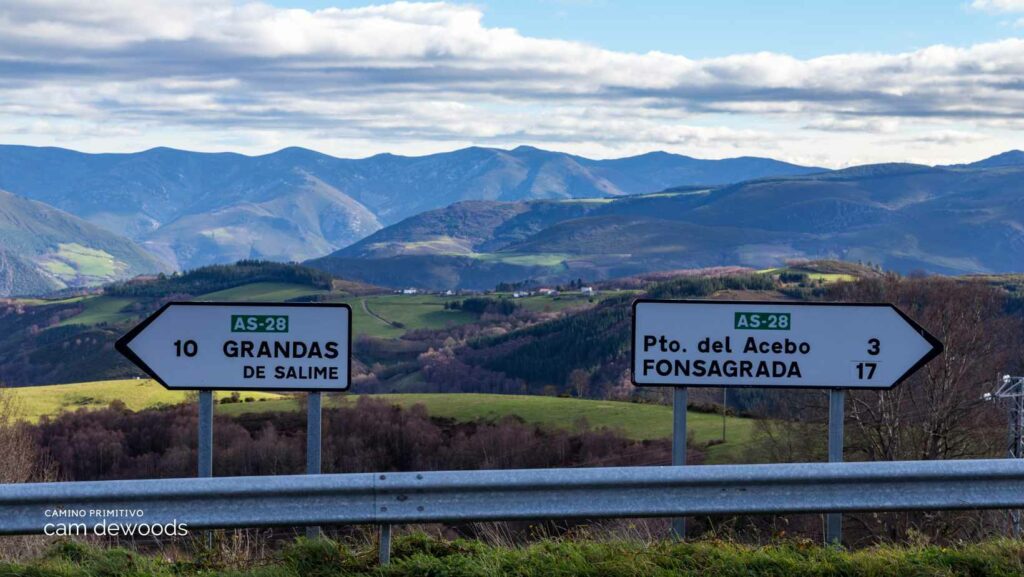
Most beautiful stages of the Camino Primitivo (my personal favorites)
People often ask me which are the most beautiful stages of the Camino Primitivo. And while every day has its own atmosphere, there are definitely a few sections that stand out — for the landscapes, the emotions they stirred, or the charm of the villages along the way. Here’s my personal top 3, based on my 2018 experience.
Berducedo
⛰️ Climbing Alto del Palo
This is one of the most unforgettable Camino Primitivo stages. Whether you start from Pola de Allande or Campiello (depending on your stage breakdown), the climb begins early. Alto del Palo, at 1,146 meters, isn’t the highest summit in the world, but you’ll feel it. The scenery is breathtaking: you zigzag through the morning mist before emerging into open landscapes, often wind-swept and completely silent. It’s a suspended moment in time.
After the climb, the descent is gentler, and the arrival in Berducedo brings a real feeling of being at the edge of the world.
A Fonsagrada
🧭 Entering Galicia
This is a long day, but absolutely worth it. What I loved here was the variety: you start high up, pass through several small villages, leave Asturias, and officially enter Galicia. There’s something symbolic about crossing that regional border.
The vibe shifts: the forests become thicker, the hamlets more traditional, and the air more humid. It’s the kind of stage that makes you feel like you’re progressing — like you’re entering the final phase of the Camino Primitivo route.
Lugo
🏛️ Leaving a historic city
Lugo is a beautiful city, especially known for its UNESCO-listed Roman walls. But for me, what stood out most was the transition out of the city. The contrast between the lively historic center and the near-silent countryside just beyond is striking.
Very quickly, you’re back on dirt paths, walking past small farms and old stone walls. It’s the perfect transition between two worlds, and a lovely stage to take at your own pace. The village of San Romao isn’t particularly memorable, but the stage itself is full of meaning and balance.
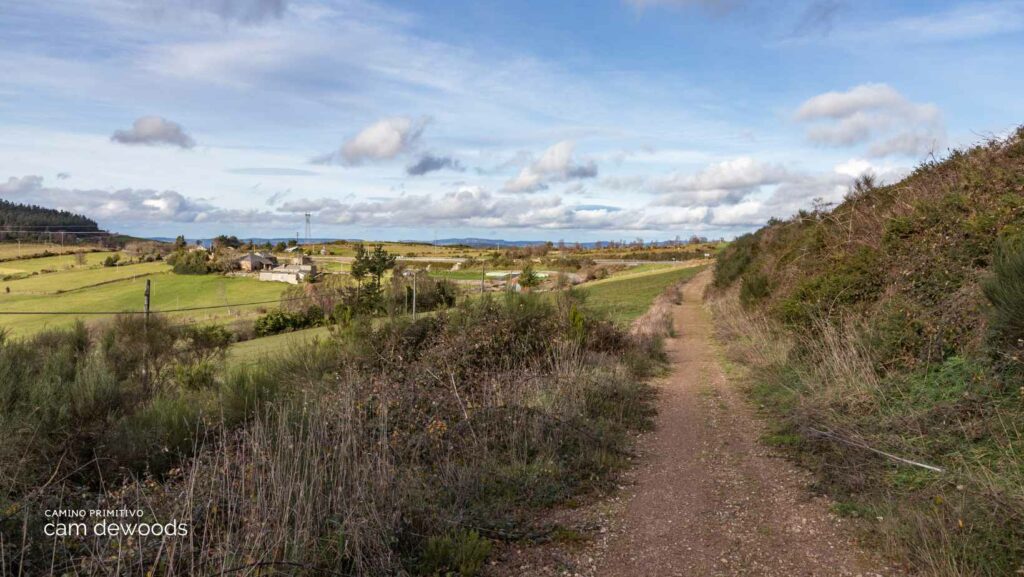
Camino Primitivo: what to expect in terms of elevation
How difficult is the Camino Primitivo?
The Camino Primitivo is often described as one of the most physically demanding Camino de Santiago routes, mainly due to its elevation profile. And yes, it’s definitely more hilly than some of the other trails. But don’t panic — we’re not talking alpine hiking here.
The Camino Primitivo route spans about 310 to 320 kilometers between Oviedo and Santiago de Compostela, with a total positive elevation gain of around 8,000 to 9,000 meters, depending on the variants. That’s not nothing, but spread over 13 or 14 days, it’s absolutely manageable — as long as you pace yourself and listen to your body.
The terrain is varied: forest trails, dirt paths, occasional asphalt. Some days you’ll climb 500 meters without even noticing; others are more intense, and you’ll feel every step. Still, this isn’t a technical or dangerous path. Just a bit more physically engaging than average.
If you’re concerned about common risks on the Camino, I’ve also written a guide on that topic: Dangers on the Camino de Santiago.
Which Camino Primitivo stages are the most physically demanding?
Here are the stages where the Camino Primitivo elevation is most noticeable, based on my experience and verified trail data:
- Pola de Allande → Berducedo
➤ Steady climb to Alto del Palo (around 600 m of elevation gain in a single stretch). One of the toughest days, especially if you start early in cold or fog. Fortunately, the descent into Berducedo is gentler. - Berducedo → Grandas de Salime
➤ A steep and somewhat technical descent to the Salime Reservoir, followed by a tough uphill to Grandas. This one hits hard, especially in summer heat. You’ll need to manage both the descent (can be slippery when wet) and the energy needed for the final climb. - Grandas de Salime → A Fonsagrada
➤ A long, mostly uphill day with a cumulative 700 m of elevation gain. Crossing into Galicia is a beautiful moment — but you have to earn it. - O Cádavo → Lugo
➤ Less technical than the previous ones, but long (30 km) and potentially tiring due to accumulated fatigue. In summer, the heat and limited water stops make it more challenging, so plan your breaks and supplies carefully.
The other Camino Primitivo stages are more moderate, but don’t be fooled: what wears you down isn’t just the big climbs, it’s the accumulation of small ups and downs over multiple days. The Camino Primitivo isn’t an impossible trail, but it does require more endurance than something like the Camino Francés.
💡 Personal tip: If you’ve never done a multi-day hike before, start with a shorter trek to get used to it. Once on the trail, feel free to split stages, stop early, or take a break when your body tells you to — there’s no shame in adjusting your plan to stay comfortable.
One of the first questions people ask when planning their Camino Primitivo:
Is there enough accommodation on the route? And do you need to book in advance?
Quick answer: yes, there is plenty — but a little planning goes a long way, especially in peak season.
Types of accommodation on the Camino Primitivo
Along the Camino Primitivo route, you’ll find the same types of lodging as on most Camino de Santiago trails. Here are the three main categories:
Pilgrim hostels (albergues)
These are the most common and usually the most budget-friendly. They fall into two types:
- Municipal or parish albergues: Very affordable (typically €5 to €10 per night), sometimes basic, but full of pilgrim spirit.
- Private albergues: Slightly more expensive (€12 to €20), often more comfortable, with smaller dorms or even private rooms. Some also offer communal dinners or breakfast — perfect after a long day of walking.
Guesthouses, casas rurales, and B&Bs
You’ll find these in most of the larger towns and Camino Primitivo stages. They’re ideal if you want more comfort or privacy. Prices usually range from €25 to €50, though some high-end stays can be more. I personally opted for this option once or twice — after a long, rainy day or when I needed proper rest.
Hotels
You’ll mostly find hotels in bigger towns like Oviedo, Lugo, and A Fonsagrada. It’s not what most pilgrims aim for, but it’s a great option if you want a “real shower and real bed” after several days in hostels.
Do you need to book accommodation on the Camino Primitivo?
It really depends on the season — and on how much you enjoy unpredictability.
- July–August: YES, especially for smaller villages with just one or two albergues. Some places only have 10–15 beds, and if you arrive too late, you might find them full. Personally, I booked the night before or even the same morning via phone or WhatsApp — it’s quick and saves you from walking extra kilometers at the end of the day.
- May–June and September: You can often walk without booking, especially if you leave early in the morning. But keep in mind that remote stages like Berducedo or A Fonsagrada can fill up quickly if there are a lot of walkers.
- Autumn–Winter: Many albergues reduce capacity or close completely. In that case, you definitely need to check ahead and plan carefully. Apps like Buen Camino, Gronze, or official Camino websites are super useful for up-to-date info.
💡 My tip: Even if you want to stay flexible, keep a list of potential accommodations for each stage, along with phone numbers. That way, you can react quickly if you’re running late or the municipal albergue is already full.
Practical tips for a successful Camino Primitivo
Even though the Camino Primitivo is shorter than some of the other Camino de Santiago routes, it requires a bit more planning — mainly due to its elevation, more spaced-out accommodations, and sometimes unpredictable weather. Here’s everything I learned, experienced, or noted during my own walk to help you get ready and set off with confidence.
Essential gear for the Camino Primitivo
You can find my full Camino Primitivo packing list elsewhere on the blog, but here are the absolute essentials for this specific trail:
- Well-worn hiking shoes
Not new, not stiff: choose shoes you’ve already broken in, that are breathable and comfortable. I’ve seen far too many pilgrims give up because of blisters. - High-quality rain jacket
Not just a thin windbreaker — rain is frequent here, especially in Galicia. A proper waterproof jacket will be your best friend whenever the skies turn grey. - Backpack between 30–40L, no more than 8–9 kg total
You’ll carry everything every day — every gram matters. - Trekking poles
Super useful for ascents and descents (especially the climb to Alto del Palo or the descent toward Grandas de Salime). - Headlamp, extra socks, foot care kit, etc.
And don’t forget clothespins — you’ll be doing laundry most evenings!
The camino shell is often what connects pilgrims—it’s a sign of belonging that sparks conversations along the way.
Camino Primitivo tips for everyday life on the trail
Budget
Plan to spend around €30 to €40 per day if you stay mostly in albergues and eat simple meals. Slightly more if you often opt for private rooms or restaurant dinners. One upside of the Primitivo? Fewer temptations — your money mostly goes to food and rest.
Food
You’ll usually find small bars and shops in most stages, but a few days are more remote. Always carry some backup snacks: bananas, energy bars, dried fruits, cheese… You might not always come across a pilgrim’s menu at lunch.
Pacing and effort
The key here is consistency > speed. Don’t stress about your daily kilometers. Start slow, listen to your body, and take real breaks. Drink water regularly, even if it’s not hot outside.
Take a rest day if you’re walking for 10+ days
A rest day mid-route is a great way to recover — Lugo is a fantastic spot for that, and worth a visit.
Keep your phone charged, your accommodation list handy, and some cash in your pocket
Some small albergues don’t take cards, and certain towns don’t have ATMs. Better to be prepared.
🎒 In short: The Camino Primitivo is a little more demanding than other routes, but with a bit of preparation and flexibility, it’s an incredibly rewarding trail. A path that offers space, silence, and the rare chance to truly listen to yourself. And that’s worth every step.
3 Responses
You don’t mention the variant. I believe it’s called hospitals? What do you think? I also along with my wife want to start on the Camino Norte and connect to the primate o. Thanks
Thanks for your message! You’re totally right — I didn’t mention the Hospitales variant because I actually took the standard route and didn’t do that alternative. I’ve heard it’s beautiful but also more demanding and remote, and I didn’t feel confident enough to take it at the time. Maybe next time! 😊
Can you please advise on travel to Orviedo from abroad? Where should I fly to, and how do I get from the airport to Orviedo?
I see that there is an airport at Santiago, so presumably I get a plane back from there.
Thank you.